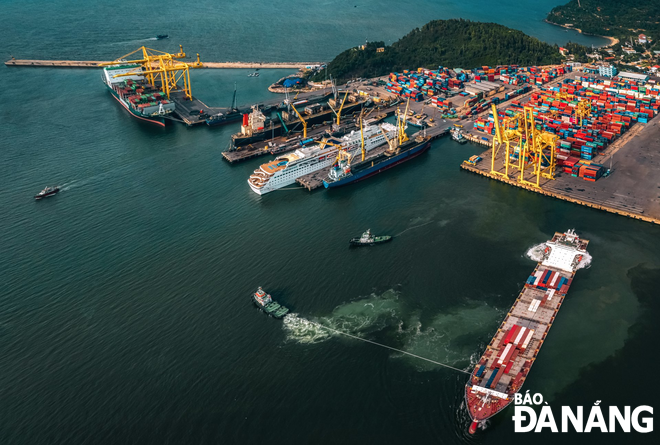Plan approved to realize Viet Nam's vision for seaport development
Viet Nam's national government has approved a plan to achieve its goals for the country's seaport system development in the 2021-2030 period, with a vision stretching to 2050.
 |
| Da Nang Port will be among the first largest port group in Viet Nam under the approved master plan for Viet Nams seaport system in the 2021-2030 period. In the photo: A stunning view from Da Nang’s Tien Sa Port. Photo: TRIEU TUNG |
The plan identifies tasks, solutions, and lists of specific projects to be carried out in each period from now until 20230.
It also identifies methods, resources, and coordination mechanisms among ministries, national government agencies, and local authorities in localities where sea ports are developed.
The plan also provides orientations for ministries, national government agencies, and local authorities in formulating their own plans for the implementation of the plan in each period.
Besides, it sets three major tasks to implement the master plan relating to performing planning procedures, completing legal framework on maritime issues, and developing infrastructure.
Policies and solutions to implement the master plan include those to attract capital for infrastructure development, human resources development, and science and technology development. The solutions must ensure social security, environmental protection, and national defense – security.
Under the master plan for the country’s seaport system development in the 2021-2030 period, with a vision stretching to 2050, the country’s seaports are divided into 5 clusters which are distributed all over the coastal line. The country’s seaports are connected to rail, road and inland water system.
The first cluster consists of five northern ports in Hai Phong, Quang Ninh, Thai Binh, Nam Dinh, and Ninh Binh.
The second one consists of six ports in the North Central Coast, namely Thanh Hoa, Nghe An, Ha Tinh, Quang Binh, Quang Tri, and Thua Thien-Hue; while the third one features eight ports in the South Central Coast, namely Da Nang, Quang Nam, Quang Ngai, Binh Dinh, Phu Yen, Khanh Hoa, Ninh Thuan and Binh Thuan.
The fourth cluster comprises five ports in Ho Chi Minh City and the southern provinces of Dong Nai, Ba Ria-Vung Tau, Binh Duong, and Long An.
The last one consists of 12 ports in Can Tho City and the southern provinces of Dong Thap, Tien Giang, Vinh Long, Ben Tre, An Giang, Hau Giang, Soc Trang, Tra Vinh, Ca Mau, Bac Lieu, and Kien Giang in the Mekong Delta.
By 2030, Viet Nam will develop a synchronous and modern seaport system with high quality services, meeting the country’s socio-economic development needs, ensuring national defense and security, maritime safety and environmental protection, improving the competitiveness of the country’s economy.
In addition, Vietnamese seaports will satisfy the demand for imports and exports, trading among nationwide localities, transit and transshipment of goods among regional countries as well as domestic and international passenger transportation.
By 2030, the ports will have the capacity to handle 1,140 to 1,423 million tonnes of cargo, (including container throughput being 38-47 million TEU), and from 10.1 to 10.3 million cruise passengers.
Under the approved master plan, Viet Nam's seaport system will be classified into 3 grades. In detail, the Lach Huyen Port in Hai Phong and Cai Mep Port in Ba Ria – Vung Tau will be planned to be special grade facilities while others in Quang Ninh, Thanh Hoa, Nghe An, Ha Tinh, Thua Thien Hue, Da Nang, Quang Nam, Quang Ngai, Binh Dinh, Khanh Hoa, Ho Chi Minh City, Dong Nai, Can Tho, Long An, Tra Vinh will be developed into the first-grade ones. In which, ports in Thanh Hoa, Da Nang and Khanh Hoa have potential to become special grade facilities. In addition, ports in 6 other Vietnamese localities will be planned to be the second grade, and such facilities in 13 localities will become the third class.
The special-class seaports are given priority for upgrading the infrastructure of international gateway terminals, including the Lach Huyen Port in Hai Phong and Cai Mep Port in Ba Ria – Vung Tau. Additionally, investments will also be poured into other areas including central region and the Mekong Delta. Particularly, international transshipment ports are being developed in Khanh Hoa in the central region – and at a terminal at Soc Trang in the Mekong Delta area, and these ports are expected to become special-class seaports when completed. With the whole system of modern seaports in place, Viet Nam expects to keep pace with seaports in the region and meet the criteria to be classified as green ports by 2050, with an average annual growth rate of 4 – 4.5%.
In order to succeed with the ambitious plan, the total investment needed by 2030 is about VND 313,000 billion (USD 13.6 billion), and it will be sourced mainly from non-state budget, businesses and other legal capitals. State budget capital is used to develop public maritime infrastructure and key areas in a bid to attract foreign investment.
Reporting by PHUONG UYEN – Translating by H.L







